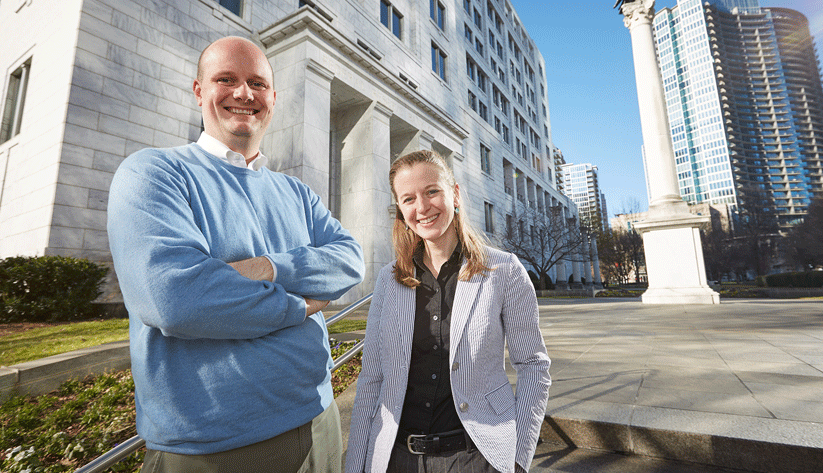
Stuart Andreason and Ashley Bozarth of the Center for Workforce and Economic Opportunity. Photo by David Fine
By many measures, the U.S. labor market is humming.
The unemployment rate is the lowest since 2000. Nonfarm payroll employment has increased every month for more than seven years.
Nevertheless, prosperity is bypassing large groups. For example, the percentage of African Americans and Hispanics in the labor force but living below the poverty line (the working poor) is more than double the share of whites. At the same time, fast-growing metropolitan areas in the Southeast including Atlanta and Nashville are among the most difficult places in the country for people born in poverty to move up the socioeconomic scale, according to research by economist Raj Chetty and coauthors.
And even if the number of job openings has been at record levels for several months, the share of working-age adults participating in the labor force remains near a 30-year low (though it has ticked up slightly), according to the U.S. Department of Labor.
The reasons for disparities in labor market outcomes—mainly whether you have a job and how much money you make—are numerous and complicated. But more effective workforce development has the potential to address what economists call "distributional" concerns, meaning that prosperity is not spread sufficiently across socioeconomic groups.
"Part of the solution to helping more people share in the prosperity that opportunity affords is to shore up the income and employment situations for families," Atlanta Fed president Raphael Bostic said in a January 8 speech. "A big part of that effort is helping to prepare parents and young adults for available jobs through workforce development."
Meanwhile, labor market trends are intensifying the need for a broader, more resilient workforce. Fed Chair Janet Yellen said in a March 2017 speech that "significant job market changes in recent years, brought about by global competition and technological advances—and the new shifting skills that these changes demand—make workforce development more important than ever before."
Training is just the start
Workforce development is more than just worker training. The field encompasses skills training, but it also touches on education, including quality early childhood experiences, small business formation and entrepreneurism, and better access to transportation—essentially any actions that create employment opportunities and help prepare people to grasp those opportunities.
To further those actions, last October the Atlanta Fed officially unveiled the Center for Workforce and Economic Opportunity.
An array of labor market forces—including the need to replace a surge of retiring baby boomers, income inequality, and rapid technological change—underscore a critical need, explained Stuart Andreason, director of the center. In particular, the workforce development community is focused on improving the job readiness of underserved populations.
Numerous experts at a Fed System conference in October noted that investing in training, education, and other forms of workforce development is far more cost effective than public spending on social programs concentrated on those left out of the labor force, such as public assistance, unemployment benefits, and incarceration.
What's more, each job that goes unfilled for lack of a qualified worker chips away at potential economic growth, Dallas Fed president Robert Kaplan said at the October conference. Likewise, every shop-floor innovation that does not happen for want of skills likewise puts a tiny dent in productivity, Andreason said.
"The notion that it's some type of charity is misguided," Samsung Austin Semiconductor general counsel and senior director of public affairs Catherine Morse said at the Fed workforce development conference. "It is workforce investment, and I think we need to shout it from the mountaintops."
A changed but not new field
Workforce development is not brand new. Once known as "manpower development" and simply "job training," the practice in a sense dates to the Works Progress Administration after the Great Depression. But the workforce development system of today started with legislation enacted in 1973, Andreason explained. Since then, the mechanics of workforce development have changed greatly.
Take federal investment. For today's major program, the Workforce Innovation and Opportunity Act of 2014, funding is 87 percent less in inflation-adjusted terms than funding for comparable programs in the 1980s, Andreason said. However, investment has increased substantially in other workforce-related programs, such as Pell grants for education.
Money is out there. All told, universities, corporations, and government entities annually spend $1.1 trillion (in 2013 dollars) on postsecondary education and workplace training, according to a 2015 study by the Georgetown University Center on Education and the Workforce.
Employers devote more than half a billion dollars a year to formal and informal training. But much of that flows to high-skilled workers: Employers channel 58 percent of their formal training dollars to those with at least a bachelor's degree, and another 25 percent to workers with some college, according to the Georgetown study (see the chart).
Many big corporations invest in workforce development perhaps as much to retain talented staff as to train them, Andreason observed. As employers focus on their hard-to-replace high earners, tackling the critical distributional issues through workforce development is largely left to other actors. Those actors make up a patchwork of state and local workforce development boards and agencies, for-profit training centers and colleges, and public technical and community colleges.
In fact, this balkanized ecosystem is one of the challenges the Center for Workforce and Economic Opportunity aims to address, in part by tapping the Fed's deep well of information on labor markets—research, data, and tools—to help policymakers and workforce developers orient their work, Andreason said.
For example, the Opportunity Occupations Monitor tracks the prevalence of jobs that pay above the median wage but don't require a college degree. Further, Atlanta Fed economists Melinda Pitts and Julie Hotchkiss have explored links between delinquent debt and curtailed life expectancy, and how much and for how long minorities may benefit from tight labor markets. The Center for Workforce and Economic Opportunity will make such Fed material accessible to workforce developers through blog posts, multimedia presentations, face-to-face discussions, and other means.
The center also aims to strengthen connections between the workforce development and community development sectors. The Atlanta Fed—and, more broadly, the Fed System—maintains longstanding relationships with practitioners and researchers in areas such as housing, public health, small business development, and community development finance. Encouraging cooperation between the workforce development and community development camps is vital to dismantle some of the barriers that impede individuals' ability to work, such as a lack of transportation and child care, addiction problems, and broad discrimination, Andreason pointed out. (Andreason discussed the center's work in an episode of the Economy Matters podcast.)
What workforce development is not
For all its potential, workforce development alone is no economic panacea. Effective training and development can help bring along would-be workers left behind in bustling metro areas such as Atlanta and Nashville and in rural areas, Andreason said, but people in smaller cities and rural areas face a different challenge.
As a result, he advises economic developers to resist the notion that a quality workforce will automatically draw eager employers and remedy widespread economic ills. Rather than a cure-all for a struggling community, effective workforce development could help workers leave a struggling area to find decent jobs, Andreason pointed out.
"This is part of a broader strategy," he said. "It's an important one that's often overlooked, but it's just one piece."




